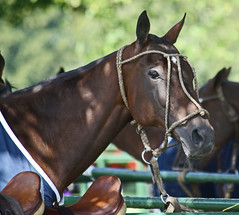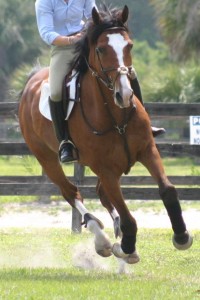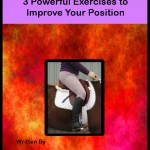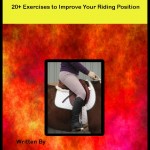Horse Training, Do Bitless Bridles Fit Into Your Training Regime
Are Bitless Bridles Less Severe?
Bitless bridles can be just as severe and distribute punishment just as easily as a bit. Most people employ a bitless bridle to circumvent any problems such as head tossing, hard mouth, running, pulling, tongue over the bit. People mistakenly think it is the bit which is the cause of the evasion, when in fact it is mostly caused by rider error.

Good hands are a function of a balanced independent seat. If you have an independent seat, you will be in balance and your hands will become educated and supple. What most people lack is educated, independent seat and therefore an educated hand.
Riders, sometimes, are pure naturals and have a soft educated feel. More often, however, riders need coaching on riding and using their hands. What is missing are the seasoned professionals to show ‘up and comers’ how to ride and use their hands. Unfortunately most equestrians never get this and will not get this instruction during their riding lessons because their own teachers lack the depth and knowledge of how to teach it so they cannot pass it on.
I think, at the heart of this is, riders are replacing their lack of skill with a piece of equipment designed to relieve them of ever having to go through the process of developing a seat and thus independent aids and eventually having educated hands that no longer cause all of these “bit issues”.

What kind of hand are your reins attached to? Are you willing to spend the time to educate your body and develop a soft feel and independent seat, or are you going to prevent the head tossing and resistance with the quick easy route – a bitless bridle?
 Try these three powerful exercises to get strengthen your position.
Try these three powerful exercises to get strengthen your position.

Well said!
Too many people look to gadgets (and often think the gadget they use is better than others) to solve their problems. Admittedly, it is a long and arduous process to learn the coordination and skill required to be able to use any piece of equipment effectively.
Thanks for your perspective on bitless bridles, Laura. One of the issues that I see (besides lack of balance or a developed seat, as you mention) is the assumption that stronger cues or harsher equipment will make a horse respond better. It’s amazing to see the transformation in horse and rider when softer is applied. Most riders are open to learning something new that helps improve the experience – for the horse too. I think that’s why a lot of people are investing in bitless. Too bad many don’t invest in lessons to become better riders.
Thank you Kathy.
Your comments are important to me. When I see people using gadgets and trendy training tools, I worry they may have missed something basic in their training. When in doubt I go back to the tried and true training pyramid and see which step has been left out.
~Laura
Thank you Nanette. Investing in lessons is investing in your own future and the future of your horse. Then again… one must pick a qualified and knowledgeable instructor!
~Laura
I completely agree that an independent seat is the first goal to be taught in riding instruction. I start almost all of my beginners bareback on an easy gaited, broad backed horse for this reason. They ride with a halter and long lead made into reins. However, there really is no need to switch into a bit if the horse and rider are properly trained. If one has hands light enough to apply just the minimum of pressure to guide the horse, then one can develop the same in a horse with only a halter and reins. Since collection does not arise from the use of a bit pulling on the fore, but rather the hindquarters, then what is the need unless one intends to use pain in the mouth? We ride all of our horses on trails, even a green horse, in a halter and reins. Lessons in balance and use of hands for the riders, clear communication in training for the foot placement of horses.
Very good article. Glad you even used the ‘most’ word – “most equestrians never get this and will not get this instruction during their riding lessons because their own teachers lack the depth and knowledge of how to teach it so they cannot pass it on.”
Riders, including the ‘instructors’ teaching them teach how to compete, not riding/horsemanship.
Yes, thank you Lauren. I am learning not to group everyone together. “Never say always”.
What you say about “Riders, including the ‘instructors’ teaching them teach horse to compete, not riding, horsemanship” is so true. That is the nail right on the head. It is a big business with money to be had by trainers and coaches who can display the trophies and ribbons and have people pay so they, or their children, can win as well.
Thank you for your comments.
~Laura
Well said Becky. I like where you say “if one has hands light enough to apply just the minimum of pressure to guide the horse, then one can develop the same in a horse with only a halter and reins”. So true. I think this porthion of riding has not been developed enough. Thank you for your comment.
~Laura
Funny, I find that most people that are opposed to the use of bitless bridles are the ones who have never given it a fair try. I’m specifically speaking of Dr. Cook’s bridles (cross-under types). I use them on all of my horses for lessons for beginners as well as seasoned riders with good seat and hands. My horses are light and relaxed and the slightest touch is all that’s needed to ask for flexion, a turn or stop (or whatever). My horses are trained to listen to the seat and weight so the bridle is there for back-up. Occasionally, a young horse “whoops it up” in Springtime (like any healthy young horse) and it takes almost nothing to get them back on track…there is no pain caused from pulling on a bit during a spook so the horse settles more quickly. I’ve done the “bit route” for years….after converting to Dr. Cook’s bridles 7 years ago, I’ll never go back!!!
Thank you for your comments. I have never used the Dr. Cook’s Bridle. I have used a ‘side pull’ and rope halters. The thing which worries me are horses which may not act so elequently to seat and weight aids. I have a horse which grinds her teeth and after riding a short time with a rope halter is better with the bridle and teeth grinding.
I agree it is a great way to teach riders as well as horses to be more aware of the weight, seat and other natural aids.
My other concern is for those people who wish to show. Hunter, dressage, flat, equitation all require a bridle and bit. Jumpers accept hackamores but dressage and hunters require some sort of bit.
Laura
I recently bought a horse (arabian) 8 yr old who I was told is great to ride. I get him home and spent 2 weeks of ground work only and working on manners , which he had none. Now I put saddle on him with a halter a soft woven reins and he tried to bite me at first, I stopped that, then he tried laying down with me on him and that didn’t work for him so now he bolts and runs in zig zags to get me off and it works, makes me jump off or hold on for dear life with no way to stop him. Turning him into circle infuriates him worse and then he has bad attitude and I refuse to work with him when he is being ill mannered under the saddle. for he is trying to hurt me. What kind of bridle/bit or anything else I can use to try and control him out in the field. He has free range of 330 acres and refuses to let me ride him… 8( I love my horse and refuse to rid of him. How can I keep him under control and stop him from bolting time and time again? People keep telling me I am idiot and should have him on the bit 8/
Danita…
I would recommend you invest in yourself and call a horseperson to come to your farm to assist you with this horse. Contact me via email (thistleridge @ hotmail.com) I can recommend some people for you to contact, or if you are in the Ottawa area, I would speak to you myself.
I think you should contact the person you bought him from and ask for a history of the horse. The horse’s history may give you some insight into why he is acting this way. I feel the behaviors you are describing are from a horse who is acting in a protective manner. It sounds as though he has had a hard life and has learned to protect himself. He has to learn to trust you and developing trust is paramount.
having the run of 300+ acres is nice for a horse but I would recommend you bring the horse in daily. You do not have to ride him, just handle him, brush, pick out his hooves, etc. Put the halter on/off and get to know each other.
Also I feel it is important to establish boundaries with him. The behaviours you describe are symptoms of someone elses ‘training‘ or lack of training. I believe horses are not inherently visicous, but rather, trained to be protective of themselves.
If you are in the Ottawa area, I would like to invite you to our Thistle Ridge Show Horse Development Clinic Ocotober 19th. We will be having a horsemanship, hands on type of clinic which may give you some insight into what is going on with your horse.
If possible, riding in an enclosed area is preferred. A 60 foot pen is large enough to ride and safe enough to prevent the horse from running away and bolting.
for additional information.
I think people ask you to sell your horse as they are concerned about you. If you feel unsafe and the horse is a danger to you, your family and friends it is the best option to invest in yourself and your horse, if you love your horse, and have an experienced horseperson give you a hand with him.
Please call or send me an email.
~Laura